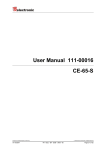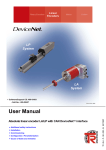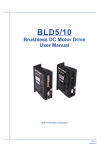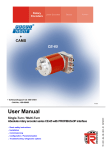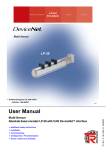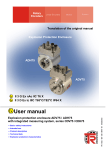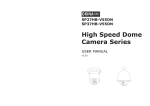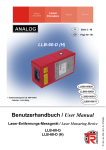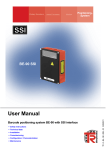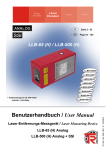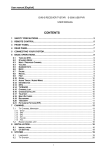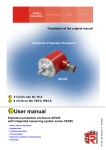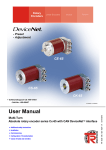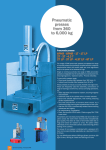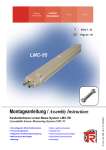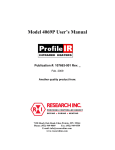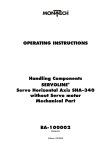Download - TR Electronic
Transcript
Rotary Encoders Linear Encoders System Motion D Seite 2 - 26 GB Page 27 - 51 Series 65 Rotary encoder series 65 • Grundlegende Sicherheitshinweise • Verwendungszweck • Allgemeine Funktionsbeschreibung • Mechanische Kenndaten • Montage • Basic safety instructions • Proper use • General functional description • Mechanical characteristics • Mounting TR - ECE - BA - DGB - 0046 - 04 03/21/2012 Montageanleitung / Assembly Instructions Assembly Instructions Absolute rotary encoder series 65 Printed in the Federal Republic of Germany 03/21/2012 TR-Electronic GmbH 2005, All Rights Reserved TR - ECE - BA - DGB - 0046 - 04 Page 27 of 51 TR-Electronic GmbH D-78647 Trossingen Eglishalde 6 Tel.: (0049) 07425/228-0 Fax: (0049) 07425/228-33 E-mail: [email protected] http://www.tr-electronic.de Copyright protection This Manual, including the illustrations contained therein, is subject to copyright protection. Use of this Manual by third parties in contravention of copyright regulations is forbidden. Reproduction, translation as well as electronic and photographic archiving and modification require the written content of the manufacturer. Offenders will be liable for damages. Subject to amendments Any technical changes that serve the purpose of technical progress, reserved. Document information Release date/Rev. date: Document rev. no.: File name: Author: 03/21/2012 TR - ECE - BA - DGB - 0046 - 04 TR-ECE-BA-DGB-0046-04.DOC MÜJ Font styles Italic or bold font styles are used for the title of a document or are used for highlighting. TR-Electronic GmbH 2005, All Rights Reserved Page 28 of 51 Printed in the Federal Republic of Germany TR - ECE - BA - DGB - 0046 - 04 03/21/2012 Contents Contents Contents ................................................................................................................................................29 Revision index ......................................................................................................................................30 1 General ...............................................................................................................................................31 1.1 Scope ........................................................................................................................................31 1.2 EC Declaration of conformity ....................................................................................................31 1.3 Abbreviations and definitions ....................................................................................................32 1.4 General functional description ..................................................................................................33 1.4.1 Absolute Encoder......................................................................................................33 1.4.2 Incremental Encoder .................................................................................................34 2 Basic safety instructions ..................................................................................................................35 2.1 Definition of symbols and instructions ......................................................................................35 2.2 Obligation of the operator before start-up ................................................................................35 2.3 General risks when using the product ......................................................................................36 2.4 Proper use ................................................................................................................................36 2.5 Warranty and liability ................................................................................................................37 2.6 Organizational measures ..........................................................................................................38 2.7 Personnel qualification; obligations ..........................................................................................38 2.8 Safety informations ...................................................................................................................39 3 Transportation / Storage ...................................................................................................................40 4 Technical data....................................................................................................................................41 4.1 Solid shaft .................................................................................................................................41 4.2 Blind shaft .................................................................................................................................42 4.3 Integrated claw coupling ...........................................................................................................43 5 Mounting ............................................................................................................................................44 5.1 Solid shaft .................................................................................................................................44 5.1.1 Flange mounting .......................................................................................................44 5.1.2 Clamping flange ........................................................................................................44 5.1.3 Clamping brackets ....................................................................................................45 5.1.4 Servo clamps ............................................................................................................45 5.2 Blind shaft .................................................................................................................................46 5.2.1 Mounting with torque holder .....................................................................................46 5.2.2 Mounting with pin-groove ..........................................................................................47 5.3 Integrated claw coupling ...........................................................................................................48 5.3.1 Mounting with coupling .............................................................................................48 6 Accessories .......................................................................................................................................51 Printed in the Federal Republic of Germany 03/21/2012 TR-Electronic GmbH 2005, All Rights Reserved TR - ECE - BA - DGB - 0046 - 04 Page 29 of 51 Revision index Revision index Revision Date Index First release 10/25/2005 00 Revision: -Modification of the standards 07/20/2009 01 Integrated claw coupling and blind shaft added 06/09/2010 02 -Modification of the warnings 08/04/2011 03 CMx-65, IMx-65, IEx-65 and IOx-65 added 03/21/2012 04 TR-Electronic GmbH 2005, All Rights Reserved Page 30 of 51 Printed in the Federal Republic of Germany TR - ECE - BA - DGB - 0046 - 04 03/21/2012 General 1 General These Assembly Instructions are contained in the delivery package and include the following topics: General functional description Basic safety instructions with declaration of the proper use Mechanical characteristics Mounting As the documentation is arranged in a modular structure, this Assembly Instructions are supplementary to other documentation, such as product datasheets, dimensional drawings, leaflets and interface-specific User Manuals etc. 1.1 Scope These Assembly Instructions apply exclusively to the following measuring system models: CE-65, CEV-65, COV-65, CMV-65, IMV-65, IEV-65, IOV-65 CS-65, CES-65, COS-65, CMS-65, IMS-65, IES-65, IOS-65 CK-65, CEK-65, COK-65, CMK-65, IMK-65, IEK-65, IOK-65 The products are labeled with affixed nameplates and are components of a system. The following documentation therefore also applies: the operator's operating instructions specific to the system, these Assembly Instructions and the interface-specific User Manual 1.2 EC Declaration of conformity The measuring systems have been developed, designed and manufactured under observation of the applicable international and European standards and directives. A corresponding declaration TR-Electronic GmbH. of conformity can be requested from The manufacturer of the product, TR-Electronic GmbH in D-78647 Trossingen, operates a certified quality assurance system in accordance with ISO 9001. Printed in the Federal Republic of Germany 03/21/2012 TR-Electronic GmbH 2005, All Rights Reserved TR - ECE - BA - DGB - 0046 - 04 Page 31 of 51 General 1.3 Abbreviations and definitions CE, CEV Absolute Encoder with optical scanning unit ≤ 15 bit resolution, Solid Shaft COV Absolute Encoder with optical scanning unit > 15 bit resolution, Solid Shaft CMV Absolute Encoder with magnetic scanning unit, Solid Shaft IMV Incremental Encoder with magnetic scanning unit, Solid Shaft IEV Incremental Encoder with optical scanning unit 15 bit resolution, Solid Shaft IOV Incremental Encoder with optical scanning unit 15 bit resolution, Solid Shaft CS, CES Absolute Encoder with optical scanning unit ≤ 15 bit resolution, Blind Shaft COS Absolute Encoder with optical scanning unit > 15 bit resolution, Blind Shaft CMS Absolute Encoder with magnetic scanning unit, Blind Shaft IMS Incremental Encoder with magnetic scanning unit, Blind Shaft IES Incremental Encoder with optical scanning unit 15 bit resolution, Blind Shaft IOS Incremental Encoder with optical scanning unit 15 bit resolution, Blind Shaft CK, CEK Absolute Encoder with optical scanning unit ≤ 15 bit resolution, Integrated Claw Coupling COK Absolute Encoder with optical scanning unit > 15 bit resolution, Integrated Claw Coupling CMK Absolute Encoder with magnetic scanning unit, Integrated Claw Coupling IMK Incremental Encoder with magnetic scanning unit, Integrated Claw Coupling IEK Incremental Encoder with optical scanning unit Coupling 15 bit resolution, Integrated Claw IOK Incremental Encoder with optical scanning unit Coupling 15 bit resolution, Integrated Claw EC European Community EMC Electro Magnetic Compatibility ESD Electro Static Discharge IEC International Electrotechnical Commission VDE Verein Deutscher Elektrotechniker (German Electrotechnicians Association) TR-Electronic GmbH 2005, All Rights Reserved Page 32 of 51 Printed in the Federal Republic of Germany TR - ECE - BA - DGB - 0046 - 04 03/21/2012 General 1.4 General functional description 1.4.1 Absolute Encoder In contrast to incremental measuring systems, the absolute measuring system provides the current position value instantaneously. If this measuring system is moved mechanically in the deactivated state, the current position can be read out directly as soon as the voltage supply is switched on again. The TR absolute measuring systems can be supplied in Single-Turn or Multi-Turn versions depending on the type required. Single-Turn This measuring system resolves a single revolution or turn of the drive shaft into measuring increments (e.g. 8192). The number of measuring increments per revolution is recorded and balanced via a code disk. This measured value is output via different interface modules depending on the type of interface used, and is repeated after each revolution. Multi-Turn Besides the angular positions per revolution, multi-turn measuring systems also record multiple rotations or turns. The drive shaft is connected to an internal reduction gear via which the number of revolutions is recorded. In the case of the multi-turn measuring system, the measured value is thus composed of the angular position and the Number of Revolutions. The measured value is also balanced and output via different interface modules depending on the type of interface used. Principle Printed in the Federal Republic of Germany 03/21/2012 TR-Electronic GmbH 2005, All Rights Reserved TR - ECE - BA - DGB - 0046 - 04 Page 33 of 51 General 1.4.2 Incremental Encoder Angular increments are recorded via a pulse disk with a fixed number of cycles per revolution. A scanning unit with an integrated optoelectronic system generates electrical signals and emits pulses (measuring increments) which are pre-processed at trigger stages. The resolution of the measuring system is defined via the number of light/dark segments (number of increments per revolution) on the pulse disk. For e.g. the measuring system outputs a signal sequence of 8192 pulses per revolution. In order to evaluate the code sequence, a 2nd signal sequence with a 90° phase offset is output for the control. The counter of an external control system can be reset with an additional zero pulse in order to define the mechanical control reference point. Principle By a corresponding counter evaluation in the user electronics the measuring system resolution can be doubled or quadrupled electronically: Reference signals not represented! TR-Electronic GmbH 2005, All Rights Reserved Page 34 of 51 Printed in the Federal Republic of Germany TR - ECE - BA - DGB - 0046 - 04 03/21/2012 Basic safety instructions 2 Basic safety instructions 2.1 Definition of symbols and instructions means that death or serious injury can occur if the required precautions are not met. means that minor injuries can occur if the required precautions are not met. means that damage to property can occur if the required precautions are not met. indicates important information or features and application tips for the product used. means that appropriate ESD-protective measures are to be considered according to DIN EN 61340-5-1 supplementary sheet 1. 2.2 Obligation of the operator before start-up As an electronic device the measuring system is subject to the regulations of the EMC Directive. It is therefore only permitted to start up the measuring system if it has been established that the system/machine into which the measuring system is to be fitted satisfies the provisions of the EC EMC Directive, the harmonized standards, European standards or the corresponding national standards. Printed in the Federal Republic of Germany 03/21/2012 TR-Electronic GmbH 2005, All Rights Reserved TR - ECE - BA - DGB - 0046 - 04 Page 35 of 51 Basic safety instructions 2.3 General risks when using the product The product, hereinafter referred to as "the measuring system", is manufactured according to state-of-the-art technology and accepted safety rules. Nevertheless, improper use can pose a danger to life and limb of the user or third parties, or lead to impairment of the measuring system or other property! Only use the measuring system in a technically faultless state, and only for its designated use, taking safety and hazard aspects into consideration, and observing these Assembly Instructions and the interface-specific User Manual! Faults which could threaten safety should be eliminated without delay! 2.4 Proper use The measuring system is used to measure angular motion and to condition the measurement data for the subsequent control of industrial control processes. Proper use also includes: observing all instructions in these Assembly Instructions and the interfacespecific User Manual, observing the nameplate and any prohibition or instruction symbols on the measuring system, observing the enclosed documentation, e.g. product insert, connector configurations etc. observing the manufacturer, operating instructions from the machine or system operating the measuring system within the limit values specified in the technical data (Assembly Instructions / User Manual) The following areas of use are especially forbidden: in environments where there is an explosive atmosphere for medical purposes TR-Electronic GmbH 2005, All Rights Reserved Page 36 of 51 Printed in the Federal Republic of Germany TR - ECE - BA - DGB - 0046 - 04 03/21/2012 Basic safety instructions Examples of typical fields of application at industrial process and control processes: Transfer machines Machine tools Gantry robots Assembly installations etc. ... Everywhere, where rotation or angular movements must be detected for evaluation Where there is a danger of physical injury and damage to property arising from jumps in the position of the measuring system! - As the measuring system does not constitute a safety component, a plausibility check of the measuring system values must be performed through the subsequent control system. - It is mandatory for the operator to integrate the measuring system into his own safety concept. 2.5 Warranty and liability The General Terms and Conditions ("Allgemeine Geschäftsbedingungen") of TRElectronic GmbH always apply. These are available to the operator with the Order Confirmation or when the contract is concluded at the latest. Warranty and liability claims in the case of personal injury or damage to property are excluded if they result from one or more of the following causes: Non-designated use of the measuring system. Improper assembly, installation, start-up and programming of the measuring system. Incorrectly undertaken work on the measuring system by unqualified personnel. Operation of the measuring system with technical defects. Mechanical or electrical modifications to the measuring systems undertaken autonomously. Repairs carried out autonomously. Third party interference and Acts of God. Printed in the Federal Republic of Germany 03/21/2012 TR-Electronic GmbH 2005, All Rights Reserved TR - ECE - BA - DGB - 0046 - 04 Page 37 of 51 Basic safety instructions 2.6 Organizational measures The Assembly Instructions must always be kept accessible at the place of use of the measuring system. In addition to the Assembly Instructions / User Manual, generally applicable legal and other binding accident prevention and environmental protection regulations are to be observed and must be mediated. The respective applicable national, local and system-specific provisions and requirements must be observed and mediated. The operator is obliged to inform personnel on special operating features and requirements. The personnel instructed to work with the measuring system must have read and understood the Assembly Instructions, especially the chapter “Basic safety instructions” prior to commencing work. The nameplate and any prohibition or instruction symbols applied on the measuring system must always be maintained in a legible state. Do not undertake any mechanical or electrical modifications on the measuring system, apart from those explicitly described in the Assembly Instructions or the User Manual. Repairs may only be undertaken by the manufacturer or a facility or person authorized by the manufacturer. 2.7 Personnel qualification; obligations All work on the measuring system must only be carried out by qualified personnel. Qualified personnel includes persons, who, through their training, experience and instruction, as well as their knowledge of the relevant standards, provisions, accident prevention regulations and operating conditions, have been authorized by the persons responsible for the system to carry out the required work and are able to recognize and avoid potential hazards. The definition of “Qualified Personnel” also includes an understanding of the standards VDE 0105-100 and IEC 364 (source: e.g. Beuth Verlag GmbH, VDEVerlag GmbH). Define clear rules of responsibilities for the assembly, installation, start-up and operation. The obligation exists to provide supervision for trainee personnel ! TR-Electronic GmbH 2005, All Rights Reserved Page 38 of 51 Printed in the Federal Republic of Germany TR - ECE - BA - DGB - 0046 - 04 03/21/2012 Basic safety instructions 2.8 Safety informations Destruction, damage or malfunctions of the measuring system and risk of physical injury! - - De-energize the system before carrying out wiring work or opening and closing electrical connections. Do not carry out welding if the measuring system has already been wired up or is switched on. Ensure that the area around the assembly site is protected from corrosive media (acid, etc.). Avoid any shocks (e.g. hammer-blow) on the shaft while mounting. Do not open the measuring system. The measuring system contains electrostatically endangered circuit elements and units which can be destroyed by an improper use. Contacts of the measuring system connection contacts with the fingers are to be avoided, or the appropriate ESD protective measures are to be applied. Disposal If disposal has to be undertaken after the lifespan of the device, the respective applicable country-specific regulations are to be observed. Device designs The technical details for customer-specific device designs, including connection technology, may differ from the designs described here and in the interface-specific User Manuals. In case of doubt, the manufacturer should be consulted, specifying the item number. Printed in the Federal Republic of Germany 03/21/2012 TR-Electronic GmbH 2005, All Rights Reserved TR - ECE - BA - DGB - 0046 - 04 Page 39 of 51 Transportation / Storage 3 Transportation / Storage Notes on transportation Do not drop the device or expose it to strong strokes! Device contains an optical system. Only use the original packaging! The wrong packaging material can cause damage to the device during transportation. Notes on transportation Storage temperature: -30 to +80°C Store in a dry place TR-Electronic GmbH 2005, All Rights Reserved Page 40 of 51 Printed in the Federal Republic of Germany TR - ECE - BA - DGB - 0046 - 04 03/21/2012 Technical data 4 Technical data The information specified in the Technical Data refers to the TR standard devices. The nameplate and any datasheet included with the device are therefore to be observed! All dimensions are to be found in the customer-specific drawings. 4.1 Solid shaft Environmental conditions Vibration, DIN EN 60068-2-6: 1996...............................≤ 100 m/s2, sine 50-2000 Hz Shock, DIN EN 60068-2-27: 1995 .................................≤ 1000 m/s2, half-sine 11ms EMC - Immunity to disturbance, DIN EN 61000-6-2: 2006 - Transient emissions, DIN EN 61000-6-3: 2007 Working temperature .....................................................0 °C…+60 °C, optional -20 °C…+70 °C Storage temperature......................................................-30 °C…+80 °C, dry Relative humidity, DIN EN 60068-3-4: 2002 .................98 %, non condensing Protection class, DIN EN 60529: 1991 ..........................max. IP 65, dependent on the type of connector, or on the connection technology Mechanical characteristics Mechanically permissible speed....................................≤ 6.000 min-1 Shaft load, at the shaft end ...........................................≤ 40 N axial, ≤ 60 N radial Bearing life time .............................................................≥ 3.9 * 1010 revolutions at - Speed .....................................................................≤ 3.000 min-1 - Operating temperature ...........................................≤ 60 °C - Shaft load, at the shaft end ....................................≤ 20 N axial, ≤ 30 N radial Permissible angular acceleration ..................................≤ 104 rad/s2 Moment of inertia ...........................................................typically 2.5 * 10-6 kg m2 Start-up torque at 20°C .................................................typically 2 Ncm Mass ..............................................................................typically 0.7 kg Printed in the Federal Republic of Germany 03/21/2012 TR-Electronic GmbH 2005, All Rights Reserved TR - ECE - BA - DGB - 0046 - 04 Page 41 of 51 Technical data 4.2 Blind shaft Environmental conditions Vibration, DIN EN 60068-2-6: 1996...............................≤ 100 m/s2, sine 50-2000 Hz Shock, DIN EN 60068-2-27: 1995 .................................≤ 1000 m/s2, half-sine 11ms EMC - Immunity to disturbance, DIN EN 61000-6-2: 2006 - Transient emissions, DIN EN 61000-6-3: 2007 Working temperature .....................................................0 °C…+60 °C, optional -20 °C…+70 °C Storage temperature......................................................-30 °C…+80 °C, dry Relative humidity, DIN EN 60068-3-4: 2002 .................98 %, non condensing Protection class, DIN EN 60529: 1991 ..........................max. IP 65, dependent on the type of connector, or on the connection technology Mechanical characteristics Mechanically permissible speed....................................≤ 6.000 min-1 Shaft load ......................................................................Own mass Bearing life time .............................................................≥ 3.9 * 1010 revolutions at - Speed .....................................................................≤ 3.000 min-1 - Operating temperature ...........................................≤ 60 °C Shaft diameter in mm ....................................................8H7, 10H7, 12H7, 14H7 Permissible angular acceleration ..................................≤ 104 rad/s2 Moment of inertia ...........................................................typically 2.5 * 10-6 kg m2 Start-up torque at 20°C .................................................typically 2 Ncm Mass ..............................................................................typically 0.7 kg TR-Electronic GmbH 2005, All Rights Reserved Page 42 of 51 Printed in the Federal Republic of Germany TR - ECE - BA - DGB - 0046 - 04 03/21/2012 Technical data 4.3 Integrated claw coupling Environmental conditions Vibration, DIN EN 60068-2-6: 1996...............................≤ 100 m/s2, sine 50-2000 Hz Shock, DIN EN 60068-2-27: 1995 .................................≤ 1000 m/s2, half-sine 11ms EMC - Immunity to disturbance, DIN EN 61000-6-2: 2006 - Transient emissions, DIN EN 61000-6-3: 2007 Working temperature .....................................................0 °C…+60 °C, optional -20 °C…+70 °C Storage temperature......................................................-30 °C…+80 °C, dry Relative humidity, DIN EN 60068-3-4: 2002 .................98 %, non condensing Protection class, DIN EN 60529: 1991 ..........................max. IP 65, dependent on the type of connector, or on the connection technology Mechanical characteristics Mechanically permissible speed....................................≤ 6.000 min-1 Shaft load ......................................................................radial coupling forces Bearing life time .............................................................≥ 3.9 * 1010 revolutions at - Speed .....................................................................≤ 3.000 min-1 - Operating temperature ...........................................≤ 60 °C Permissible angular acceleration ..................................≤ 104 rad/s2 Moment of inertia ...........................................................typically 2.5 * 10-6 kg m2 Start-up torque at 20°C .................................................typically 2 Ncm Mass ..............................................................................typically 0.7 kg Printed in the Federal Republic of Germany 03/21/2012 TR-Electronic GmbH 2005, All Rights Reserved TR - ECE - BA - DGB - 0046 - 04 Page 43 of 51 Mounting 5 Mounting 5.1 Solid shaft The Measuring systems with solid shaft are connected to the drive shaft via an elastic coupling, which compensates for any deviations in the axial and radial direction between the measuring system and drive shaft. This avoids excessive strain on the bearings. 5.1.1 Flange mounting The centering collar with the corresponding fit centers the measuring system in relation to the shaft. It is fixed to the machine by means of three screws in the flange. 5.1.2 Clamping flange The centering collar with the corresponding fit centers the measuring system in relation to the shaft. It is fixed to the machine by means of the clamping flange. TR-Electronic GmbH 2005, All Rights Reserved Page 44 of 51 Printed in the Federal Republic of Germany TR - ECE - BA - DGB - 0046 - 04 03/21/2012 Mounting 5.1.3 Clamping brackets The centering collar with the corresponding fit centers the measuring system in relation to the shaft. It is fixed to the machine by means of two clamping brackets which are fastened with four screws. 5.1.4 Servo clamps The centering collar with the corresponding fit centers the measuring system in relation to the shaft. It is fixed to the machine by means of three servo clamps. Printed in the Federal Republic of Germany 03/21/2012 TR-Electronic GmbH 2005, All Rights Reserved TR - ECE - BA - DGB - 0046 - 04 Page 45 of 51 Mounting 5.2 Blind shaft 5.2.1 Mounting with torque holder The rotating of the measuring system by the arising torque is prevented by a torque holder. Additionally occurring axial or radial displacements of the drive shaft will be compensated and machine vibrations absorbed. Mount measuring system with the torque holder by means of two M3 screws onto the drive and protect it against slipping on the shaft by tighten the clamping ring with the hexagon key. TR-Electronic GmbH 2005, All Rights Reserved Page 46 of 51 Printed in the Federal Republic of Germany TR - ECE - BA - DGB - 0046 - 04 03/21/2012 Mounting 5.2.2 Mounting with pin-groove The rotating of the measuring system by the arising torque is prevented by a dowel pin on the drive side. For the mounting of the dowel pin the measuring system on the flange side possesses a dowel pin adapter. This way of mounting shouldn't be used for precision applications. Radial deviations of the shaft can cause an easy torsion of the measuring system and cause thus an angular error. Protect measuring system against slipping on the shaft by tighten the clamping ring with the hexagon key. Printed in the Federal Republic of Germany 03/21/2012 TR-Electronic GmbH 2005, All Rights Reserved TR - ECE - BA - DGB - 0046 - 04 Page 47 of 51 Mounting 5.3 Integrated claw coupling 5.3.1 Mounting with coupling Measuring systems with integrated coupling are standalone devices and cannot be produced by remodelling of a standard device with shaft. Features: Short construction length (integrated coupling in the measuring system shaft) Simple and fast mounting / dismounting Radial and axial tolerance to the customer shaft. Only few components necessary TR-Electronic GmbH 2005, All Rights Reserved Page 48 of 51 Printed in the Federal Republic of Germany TR - ECE - BA - DGB - 0046 - 04 03/21/2012 Mounting Mounting example Printed in the Federal Republic of Germany 03/21/2012 TR-Electronic GmbH 2005, All Rights Reserved TR - ECE - BA - DGB - 0046 - 04 Page 49 of 51 Mounting Radial- / angle misalignment The couplings can take up either a radial ( Kr) or an angle misalignment ( Kw). Carefully and exactly aligning of the shafts increases the life time of the couplings. The shaft ends which can be connected should be mounted in bearings directly before and behind the coupling. Circulating parts must be protected against unintentionally touching by the user (Safety of machines see DIN EN 292 part 2). TR-Electronic GmbH 2005, All Rights Reserved Page 50 of 51 Printed in the Federal Republic of Germany TR - ECE - BA - DGB - 0046 - 04 03/21/2012 Accessories 6 Accessories 490-00101 Info 490-01001 Software- and Support-DVD: Switch cabinet module PT-6 490-00105 Switch cabinet module T-15/2 490-00310 USB PC-Adapter V4 49-110-xxx Clamps and mounting brackets 34-000-xxx Various couplings 85-900-035 Bearing Module TR-V-TI-GB-0020 Info TR-V-TI-GB-0060 Info TR-E-TI-DGB-0074 34-000-215 (GS5) ROTEX® spider 92 Shore A (yellow) 34-000-216 Hub ROTEX® GS5 AI-H 5 H7 Info TR-V-TI-GB-0400 Info TR-V-TI-GB-0410 TR-V-TI-GB-0420 TR-V-TI-GB-0421 TR-V-TI-GB-0430 Info TR-V-TI-GB-0440 Printed in the Federal Republic of Germany 03/21/2012 - GSD-, EDS-, Typeand XML- Files + Documentations - Programming Software - Driver TR-Electronic GmbH 2005, All Rights Reserved TR - ECE - BA - DGB - 0046 - 04 Page 51 of 51


























